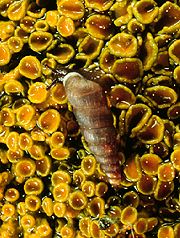Herbivore-lichen interactions
Bruno Baur ![]() , Lars Fröberg (University of Lund, Sweden)
, Lars Fröberg (University of Lund, Sweden)
A variety of species of oribatid mites, beetles, Lepidopteran larvae and terrestrial gastropods live in and feed on lichens. We examine different aspects of gastropod herbivory on lichens. On limestone walls in the grassland Great Alvar on the Baltic island of Öland, south-eastern Sweden, we found grazing damage occurring in 33 (63.5%) of the 52 lichen species recorded. Two lichen-feeding snail species coexist on these limestone walls, namely Chondrina clienta and Balea perversa. The results of laboratory experiments showed that the two species compete for limited food resources (lichens) and that the snails differ in their food preference. For example, B. perversa can grow and reproduce when kept on a Xanthoria parietina diet. B. perversa feeding on X. parietina absorbs parietin, which is also transferred from the mother to the eggs in the reproductive tract of the snail.
Keywords: gastropods - herbivory - limestone - food preference - growth
Selected publications
Schmera D, Baur A & Baur B (2015) — Size-dependent shell growth and survival in natural populations of the rock-dwelling land snail Chondrina clienta — Canadian Journal of Zoology 93: 403–410
Fröberg L, Stoll P, Baur A & Baur B (2011) — Snail herbivory decreases cyanobacterial abundance and lichen diversity along cracks of limestone pavements — Ecosphere 2: art38
Fröberg L, Baur A & Baur B (2006) — Field study on the regenerative capacity of three calcicolous lichen species damaged by snail grazing — Lichenologist 38: 491–493
Fröberg L, Berg CO, Baur A & Baur B (2001) — Viability of lichen photobionts after passing through the digestive tract of a land snail — Lichenologist 33: 543–545
List of all publications related to this project
![]()

![]()